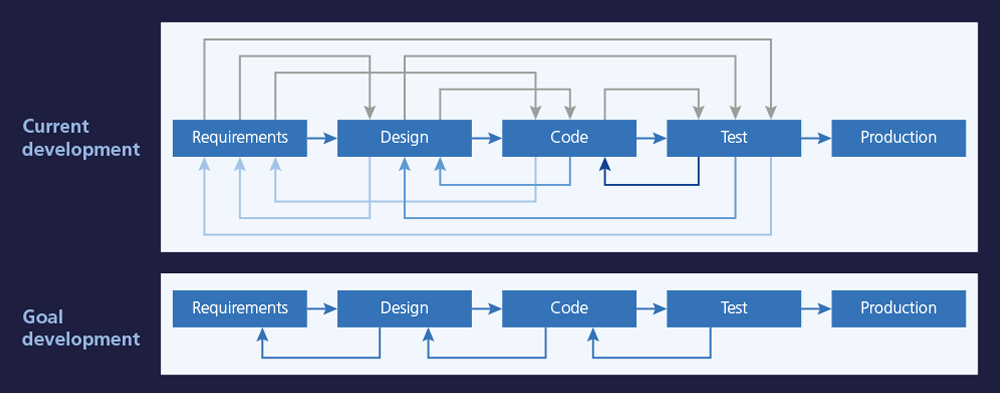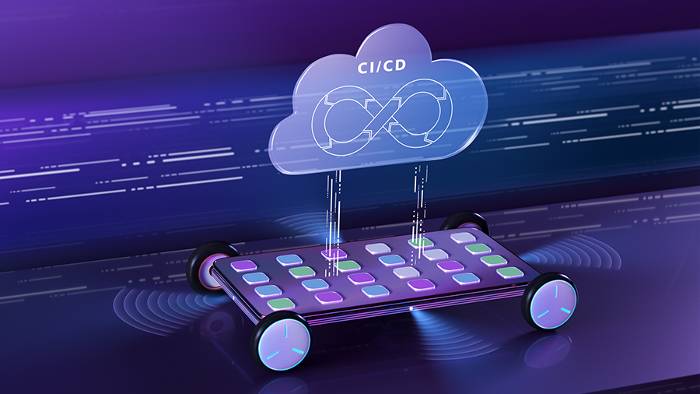The Global Electrical Engineering and Software - Virtual Engineering Team (EE&SW VE Team) of Stellantis – formerly Fiat Chrysler Automobiles (FCA) – is implementing a new and improved software development and test platform that embraces agile technology practices and virtualization capabilities to enable early validation.
By being able to quickly adapt to changes that can arise at any stage of the software development cycle, such as new requirements, code errors, or integration issues, the new test platform will leave the EE&SW VE Team better positioned to secure optimal outcomes. “At FCA, we focus on best software development and testing practices,” said Sangeeta Theru, Vehicle Modeling and Integration Lead, EE&SW VE, FCA US LLC. “Virtualization is a key concept when we talk about agility in the controls and software development process.” Some of the main benefits that are supported by virtualization include:
- A reduced number of costly iterations by frontloading tests
- Iterative development of complex new functions at an early stage
- Ability to perform development work on a laptop/computer without re- quiring the physical controller
- Reuse of plant models and test scenarios across xIL test platforms [model-in-the-loop (MIL), software-in-the-loop (SIL) and hardware-in-the-loop (HIL)
Valuable Time and Costs Savings
A key incentive of the FCA virtual test platform is the capability to perform early software validation. This is made possible by creating a virtual version of the electronic control unit (ECU) under test. The virtual ECU is a physically equivalent replica of the real ECU. By utilizing virtual ECUs in software-in-the-loop (SIL) testing, early and realistic ECU software validation can be performed – even before the first prototype becomes available. This process allows issues to be identified and debugged much earlier in the development process, saving valuable time and costs. The EE&SW VE Team began its initiative to develop a virtual test platform in 2016 and has been working closely with dSPACE. Their test platform includes dSPACE VEOS, a PC-based simulation platform that allows for virtual validation. VEOS makes it possible to simulate a wide range of different models, such as function models, Functional Mock-up Units (FMUs), virtual ECUs (V-ECUs), and vehicle models, in early development stages – independent of any specific simulation hardware. The latest version of VEOS supports the AUTOSAR Adaptive Platform for high-performance computing requirements, such as applications for autonomous driving. “Early validation reduces costly iterations due to issues or bugs identified very late in the vehicle program development timeline,” explains Giancarlo Di Mare, Head of Virtual Engineering, FCA Italy S.p.A. Mr. Di Mare adds that VEOS and the virtual test platform technology integrate well into the overall model-based development and ECU testing workflow. The integrated workflow consists of database and workflow management to collaborate within different teams across different test phases and xIL environments (MIL, SIL, HIL). FCA currently uses an internal, keyword-driven tool (VST) for test automation and traceability to requirements and test cases in IBM Rational Quality Manager (RQM), which allows for remote global testing in all FCA test facilities. Additionally, FCA is using the dSPACE Test Solution Package (TSP). TSP is a product-bundle solution for performing efficient & automated ECU testing. It includes dSPACE SYNECT (data management and collaboration software), dSPACE AutomationDesk (test authoring and automation tool), and the dSPACE Test Authoring Framework (TAF). “Using TSP, we are able to establish traceability with IBM RQM, handle variants of system tests and parameters, and perform optimized test authoring and synchronization of test steps in the RTC/RQM process,” summarizes Sisay Molla, Vehicle modeling and Integration, FCA US LLC.

VEOS is a PC-based simulation platform for validating the software of electronic control units (ECUs) in early development stages.
Improved Test Efficiency
With the virtual testing platform technology in place, the EE&SW VE Team is working toward three significant goals: 1) reducing testing on HIL, 2) frontloading tests to software-in-the-loop (SIL), and 3) synchronizing and managing requirements across the de- development stages and among various teams and suppliers. To date, the EE& SW VE Team has used this technology to successfully virtualize and implement a hybrid control processor (HCP) in a closed-loop virtual test platform and to virtualize and implement an engine controller in a closed-loop virtual test platform, based on AUTOSAR software architecture with production basic software. The team is also working on the integration of a virtual transmission controller as well as the virtualization of legacy code.
Global Team Effort
The project team from FCA and dSPACE collaborated extensively to develop and implement the virtual test platform. The core group included members of the EE&SW VE Team responsible for virtual ECU generation and integration in the plant models to generate the closed-loop virtual test platform. The user group includes members from the FCA Controls Team Centers of Excellences (COEs) and software teams. This large team had quite an international footprint with various FCA contributors from FCA North America, Italy, Brazil, India, etc., as well as dSPACE team members from the USA and Germany. Together, the FCA and dSPACE teams took on several challenges, including the integration of AUTOSAR basic software from third-party commercial vendors, developing a new ECU with its own software architecture, and the virtualization of complex device drivers. According to FCA, the virtual test platform is currently utilized for control development and software testing and is showing great promise for early validation.

An example of a high-level workflow for hybrid control development. Using virtual ECUs and the HCP Virtual Test Platform, the development
team benefits from a more efficient build and time process and can perform tests earlier.
About the authors:

Sangeeta Theru
Vehicle Modeling and Integration Lead, EE&SW VE, FCA US LLC.

Giancarlo Di Mare
Head of Virtual Engineering, FCA Italy S.p.A.

Sisay Molla
Vehicle modeling and Integration, FCA US LLC.










